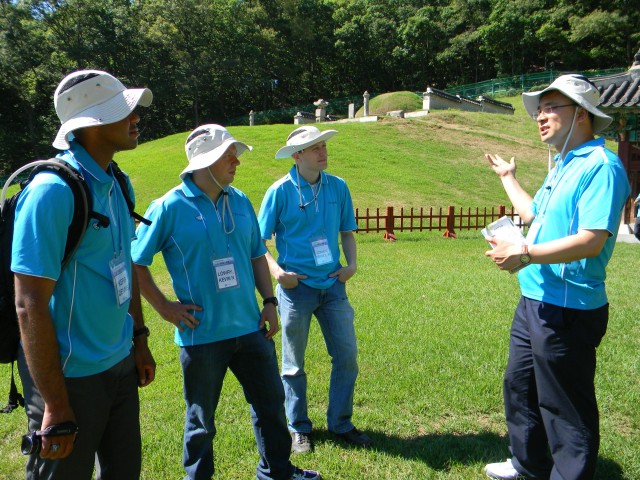GYEONGGI PROVINCE, South Korea -- In the wake of the South Korean warship Cheonan sinking and the death of 46 sailors, the Gyeonggi Province Office of the Vice-Governor Choi Hong-chul gave a group of 2nd Infantry Division Band members and Koreans a tour, June 23, through early and late Korean history that included the Demilitarized Zone, or DMZ.
In his opening remarks to the tourists, Choi said he hoped the tour commemorating the 60th anniversary of the Korean War would give the 11 band members and 109 Korean veterans, families, students and North Korean defectors an opportunity to reflect on the importance of national security to South Korea.
"Sixty years has passed since the Korean War broke out and 60 years since South Korea was founded, and now 60 years later our country is the 10th largest economy in the world," he said.
The spirit of the Korean people following the attack March 26 has been low as the nation mourned the dead sailors, but tours such as this will help to lift their spirits, said Kim Chang-hoon, spokesman for the vice governor.
"USFK Soldiers, especially 2nd ID Soldiers, train and work hard to protect South Korea," Kim said. "Many American Soldiers, Sailors, Marines and Airmen sacrificed for our country during the Korean War. It means a lot to the people of Korea and the Vice Governor's Office to bring Soldiers to the DMZ area. Because it is a neglected or forgotten area, we, by inviting 2nd ID Soldiers will share the message - peace is important; the peace and security the 2nd ID Soldiers keep means a lot to all of us. We want to give them a chance to think about why they are here."
The first stop on the tour was a trail used by North Korean refugees at the beginning of the Korean War. Perhaps many who fought for South Korea during the war recall images of thousands of refugees trekking south through trails in the bush carrying their possessions on their backs as they fled to escape the attacking North Korean and Chinese armies.
The young students and Soldiers had to make the quarter-mile trek through the brush to see the difficult trail traversed in 1950. After arriving at the end of the memorial trail, Spc. Daniel Estes of the 2nd Infantry Division Band said he couldn't imagine how refugees could complete the long journey because he found it rough without carrying anything.
Tourists were reminded that when North Korea wants to get help in time of war, they ally with China. Indeed such alliances exist more than once in Korean history because all recall that South Korea and the United Nations fought China as well during the war.
The final stop of the tour was the Royal Tomb of King Gyeongsun (r. A.D. 927-935), who was the last monarch of the Silla Kingdom (57 B.C. - A.D. 935). He was a descendant of King Munseong (r. 839 - 857). Gyeongsun became king in 927.
Realizing Silla lacked the strength to fend off the ruthless assault of Taejo Wang Geon of the Later Baekje Kingdom (892-936) and to avoid needlessly shedding the blood of his people in a prolonged war, Gyeongsun peacefully relinquish the throne in 935 to Wang Geon, the founding king of Goryeo (918-1392). It is the only royal tomb from the Silla kingdom not located in Gyeongju - home to many of Silla's most significant cultural sites.
Kim said peace, security and freedom remain a top concern for the nation's leaders and the visit to the royal tomb underscores this importance to South Koreans.
Related Links:
60th Anniversary of the Korean War


Social Sharing